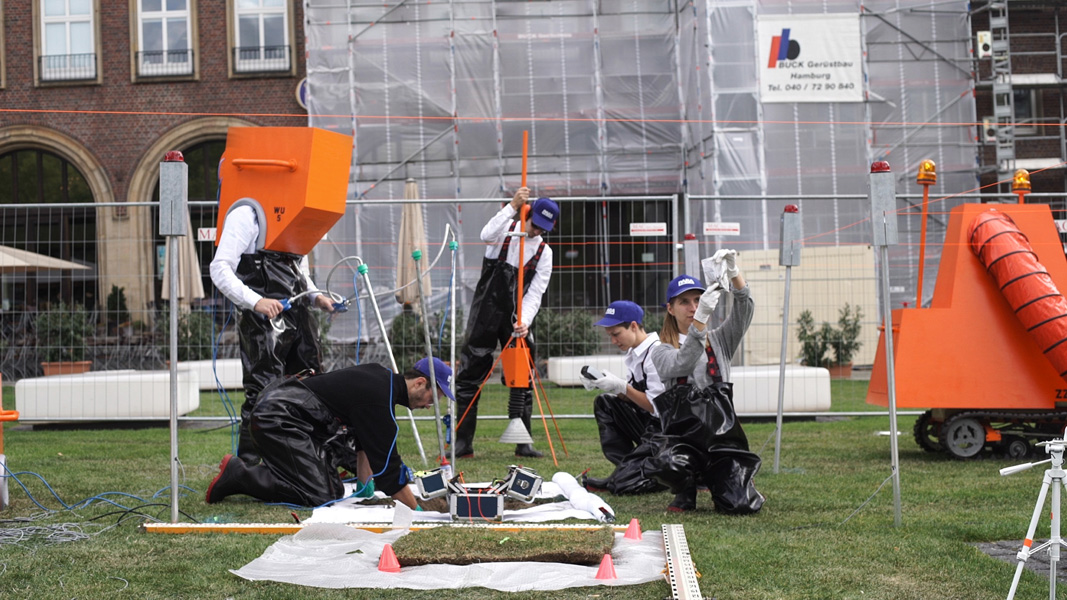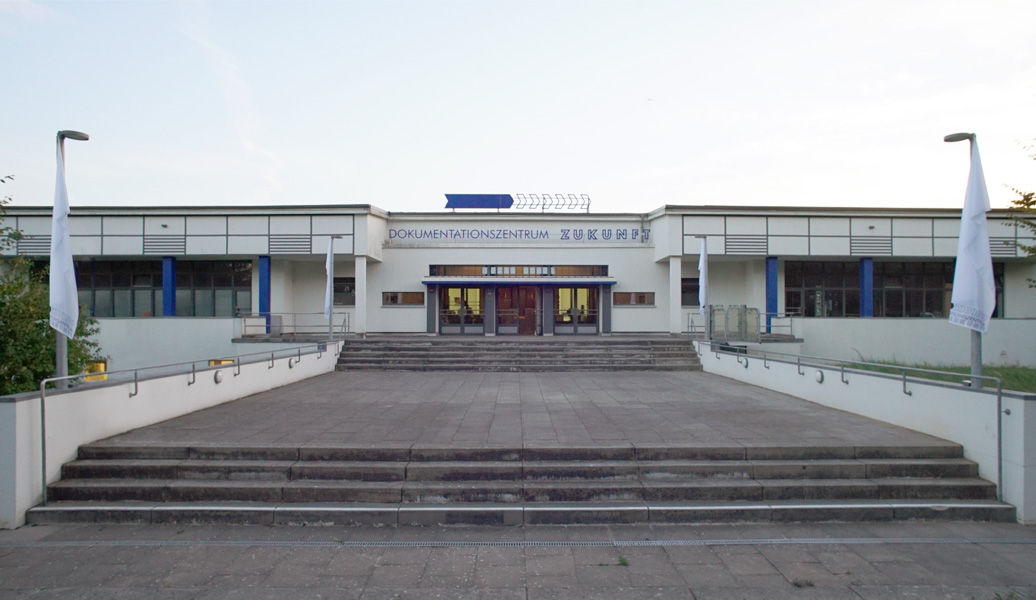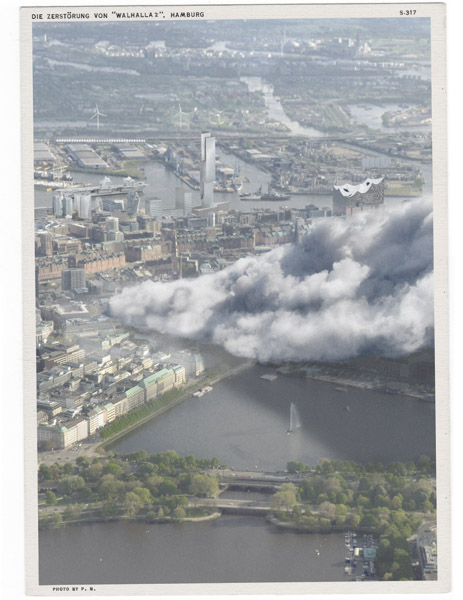 |
|
WALHALLA 2 (de|en) PARA int.
In the heart of both Hamburg and Berlin minimally invasive excavations are taking place in order to find the ruins of yet unknown German national monuments. As it will turn out, the remains of this second Walhalla are not dating back to the past but rather seem ro be the results of current political developments. Wich futures are we heading to so rapidly and how could they be ruined before approaching them? The disoveries will be presented to the general public at Dokumentationszentrum Zukunft (Future Documentation Cente).
__________________________________________________ _____________ |
|
The special exhibitions promise a reappraisal of the coming, empathy in the possible and critical reflexion upon an epoch that still waits for some, that is yearned for by a few and will be destroyed by others. __________________________________________________ ___________ |
 |
 |
 |
 |
 |
 |
|
.jpg) |
 |
 |
 |
Rede zur Pressekonferenz "September 19 2018 - within the last 48 hours minimally invasive excavations took place at Dom square, Hamburg, conducted by the exploration group PARA International, the Archeological Museum Hamburg and the Future Documentation Center (FDC). The first results that we will present you today do confirm - We are standing atop the ruins of a yet unknown German national monument. Its existence has been repeadedly predicted by the archeologists as "Walhalla 2" yet have scientists been unable to precisely date Walhalla 2 for the last years. To which time do the remnants date back to? With the help of the radio carbon methode the finds were difficult to date. This method is measuring the amount of radioactive C14 atoms that is to be found in a constant ratio within the atmosphere and living matter. Once covered by soil the ratio constantly decreases over a long time. The less C14 atoms the older the find. In our case the remnants at Domplatz clearly show a much higher C14 concentration than todays atmosphere. This confirms what earlier discoveries from Brussels, Gdansk, Thuringia were suggesting: The ruins of the Walhalla 2 national monument do not date back to the past. In fact they are the outcome of current political developments. Meanwhile the archeological Musem Hamburg, originally cooperation partner during the excavation, pulled back from the project. "Archeology takes care of findings from the past. For ruins from other tenses the AMH does not see itself responsible." (Prof. Dr. Weiss) Prof. Dr. Weiss, director of the Archeological Museum Hamburg, declared the cooperation to be over this morning. The Documentation Center regrets this step, since since its founding in 2015 the DZ has seen itself as a disruptive player in the game of history, as a literal clog in the wheels of reality, as an institutionalized Cassandra, the prophetess cursed by Apollo, who no one wanted to believe because it is more convenient to settle in a diffuse fear of the future than to deal concretely with the warning of what becomes the present every second. __________________________________________________ _____________ |
The search for Walhalla 2 began as a reaction to Björn Höcke's (AfD) speech of 2015, in which he demanded that Germany should finally erect "monuments instead of memorials". This future had to be ruined by the FDC by excavating the ruins of these very monuments - by digging up the potentiality of this future. An inverted funeral. A de-burial of the possible. A ritual purification of this political "vision" itself. Proceeding our research in the soil we are realizing in horror that the longer we search for Walhalla 2, a neoidentitarian future that is being created every day in this country, the more this future is matching the present in which we live. Walhalla 2 has already become reality. The present is already escalating. At archaeological symposia there is an increasing politicization, from which the DZ as an institution emerged in the last consequence. The past represents a concept that must no longer be of sole interest for archaeological research in Germany. We see it as our mission to ruin certain futures. Walhalla 2 is thus in a sense the glaucoma in the eyeball of the discipline, as Johanna Clairmont will sufficiently explain in her standard work "I will communicate nothing - Walhalla 2 as the abyss of archeology". Prof. Dr. Anselm Schenkluhn - PARA Chief Excavator __________________________________________________ _____________ |
 |
 |
|
 |
 |
 |
 |
 |
 |
 |
 |
 |
 |
 |
 |
 |
 |
 |
 |
|
|
 |
 |
Attempt of an interpretation - Walhalla Connectors Democracy was extinct, said those who were in the minority. It was at its peak, the others said. In the late 2020s - 2030s the political landscape was completely fragmented. There was suddenly a party for everything and everyone. It was not unusual for twelve or more groups to take over the government together. Coalition negotiations tended to run for the entire legislative period and the country was usually run by those who had just been voted out of office. The communication over different generations of social networks had led to the fact that the country consisted of small groups, which separated so hermetically from each other that they would have been called their own nation in other times without further notice. Only the spatial distribution of all these groups over the entire surface of the republic created the illusion of a nation. Otherwise, the realities developed in completely different directions. Not only were different languages and dialects being spoken, opposing values and legal views were not uncommon. It was a question of time when the recollection of romanticism would begin. In the middle of the 19th century, the German-speaking regions in the centre of Europe were also anything but united by friendship - a labyrinth of small states, often hardly larger than cities, which distinguished themselves from their neighbours by their own identity, own dimensions, currencies, symbols of power and, last but not least, their own armies. Romanticism created the transfigured image of a nation. A movement that was concerned with constructing a sense of community. One nation could only be created if one could refer to landscapes of a common Heimat, to heroes of a common history, to the poetry of a common culture. A temple erected by the Bavarian King Ludwig I and named Walhalla after the Germanic hoard of gods, overlooking the Danube, honoured important personalities of the "German tongue". So there was not much left of democracy. Although many called for a dictator, the dissenting voices were too strong. Whenever something had to be decided, egoism and a lack of decisiveness were the reasons it went well wrong.
__________________________________________________ ___________ |
The "Federal Centre for Political Order", after extensive studies, therefore came to the conclusion that a new cultural identity was urgently required in order to bind together the masses of free individuals and small, hardly influenceable and uncompromising groups into a great nation capable of tackling the great national problems of the coming centuries. International organizations to solve global problems had been dissolved in the middle of the 21st century. Since the introduction of the state advisory artificial intelligence, which made forward-looking calculations in the computing centers of the Federal Institute for Future Analysis for the Benefit of the Nation, decisions could finally be made almost risk-free and almost objectively. The rescue of future generations of German full citizens was, of course, often only possible against the will of the living generation and almost exclusively against the will of the candidates of full citizenship. One had learned from history and avoided changing the regime into a dictatorship. Although this would have been much easier from an administrative point of view, the intention was to preserve the international integrity and to maintain the extremely lucrative tourist image as one of the last Western democracies. The Federal Centre for Political Order was interested in the greatest possible stability. In order to prevent upheavals and revolts, coups, revolutions, marches and noisy demonstrations, early investments had been made in the political order and the "Programme Walhalla II" had been created. Walhalla II had initially been a working title. The working group for Political Osmosis had taken a remote Bavarian valley from the Internet and experimented with injected and induced identity in a local network simulation. The discoveries from immersion, which had long ago found its way into the most diverse areas such as warfare, sexual practices, theatre or machine control centres, had been transferred to training courses in political order and had proved to be extremely effective. The test subjects were connected to the system individually or in small family-sized groups and entered the program immersively.
__________________________________________________ ___________ |
"Germany" was the name of the experience it was all about. "You are Germany! It was an overlay of experiences lived through together, common experiences, common tastes, common joys and pleasures. Although the experience was different for each test person (the artificial intelligence had access to the centrally stored web histories of the citizens and could therefore reconstruct all peculiarities and preferences of the citizens in unimaginable speed), the test persons felt very connected after using the program. Some citizens spoke of emotional attachment, others were now devoted to their nation in a way previously known only in the physical love, ready to give up themselves for a nation simulation that promised to satisfy all their needs. The fact that the simulation of the nation was psychologically little more than a distorting mirror was concealed from the delighted and narcissistic test subjects. After Walhalla II had proved its worth as a beta version, a highly remunerated design competition was launched for the design of the new national monuments. Although many of the submissions sought historical references, worked with columns, pilasters and references, there was no submission that did not fail because of a thoroughly clumsy execution. The high-ranking jury chose a number of designs in the final round that referred to the humanist ideals of modernism. The jury's decision, however, was ultimately unanimous in favour of a submission that wanted to collaborate with an electronics retail chain. The authors promised to be able to erect twice as many monuments as required on the same budget. The aesthetics were impressive, as well, strongly orienting themselves on the latest product generation of personal adapters. Thus, they were awarded the title "Particularly Contemporary". It didn't take long and new objects shot up all over Germany. The "Walhalla Connectors" were erected in different dimensions and with different numbers of access openings according to the size of the respective agglomerations. In villages they tended to resemble street furniture, while in exposed inner-city locations in German metropolises they eclipsed cathedrals, government buildings and even the shopping malls.
__________________________________________________ ___________ |
The Walhalla Connectors were monument and docking station all in one, meeting place for girlfriends (in possession of full citizenship) and retreat, here was where prayers were prayed and loud feedback was given. To some the Walhalla Connector was almost what used to be known as sex cinema in the old days, to others it was a confessional. Groups of teenagers met at the Connectors to playfully control the national borders, while middle-aged women came here to fight against the overwhelming threats the new era had for them. Every four years, every full citizen was urged to elect the government in the Connectors. But although every full citizen saw something different in the immersive connectors, they were all connected and part of the same story. The citizens either connected wirelessly to the Walhalla Connector or plugged themselves in locally with their sensory slaves to indulge in the New Germany with their whole bodies. The connectors were of deep black color and crystalline surface and reminded of both the exotic blossoms of carnivorous plants and a radio alarm clock. Similar to the national monuments and Bismarck towers built throughout the country at the end of the 19th century, each Walhalla connector was crowned with an oversized human figure. But instead of Bismarck, it was the full citizens themselves whose torsos alternated and sometimes flickered as if carved out of limestone, enthroned with expressive gestures on the podest-like connectors. The disfigured Selfie grin had gradually given way to a dignified facial expression, since every selected full citizen was now simultaneously small building block, proud representative and avatar of the best of all nations. __________________________________________________ ___________ |
 |
 |
 |
__________________________________________________ ___________ |
PARA excavation direction, concept, artistic art direction and curation: Peter Behrbohm, Josephine
Hans, Anselm Schenkluhn, Bastian Sistig and Kolja Vennewald Digging apparatuses and special machines: Peter Behrbohm, Kolja Vennewald Architecture: Peter Behrbohm, Anselm Schenkluhn, Kolja Vennewald Special Atmosphere Container: Hans Martin Schlesier - Popticum Uniform: Josephine Hans Text and Document: Holger Fröhlich, Julia Lauter, Philipp
Röding, Peter Behrbohm and Bastian Sistig Image Research, Archive and Expedition: Jonas Fischer, Philipp Meuser Dokumentation: Peter Behrbohm, Jonas Fischer and Phillip Meuser Audio Fragments: burgund t brandt Artifacts: Øystein Aasan, Peter Behrbohm, Samantha Bohatsch, Lena Marie Emrich, Zuza Golinska, Josephine Hans, Marie
Köhler, Gregor Rozanski, Karoline Schneider und Bastian Sistig Excavation Team Hamburg: Peter Behrbohm, Sarah Besch, Daniel Degeest, Josema Enriquez, Jonas Fischer, David Gómez, Josephine Hans, Raha Emami Khansari, Andrea Krohn, Amelie Neumann, Klara Oehler, Anselm Schenkluhn, Friederike Schneider, Bastian Sistig, Kolja Vennewald, Alyssa Marie Warncke Excavation Team Berlin: Emma Adler, Felix Becker, Peter Behrbohm, Ruben Beider, Markus Bühler, Georg Bütow, Thomas Leo Chapman, Jonas Fischer, Cora Guddat, Josephine Hans, Albert Herrmann, Rike Horb, Julie Legouez, Brian Karp, Amelie Neumann, Niels
Pegel, Diane Penrad, Klara Reitberger, Anselm Schenkluhn, Friederike
Schneider, Bastian Sistig, Anton Steenbock, Jacob Steinfelder, Kolja
Vennewald Graphics: Peter Behrbohm, Leon Lechner Layout: Kolja Vennewald Museum Shop: Josephine Hans Docent: Janine Meißner
Produktion Management: Friederike Schneider Guidance: Maria Kusche Technical Management: Florian Fink Technical Support: Walter Habrich Public Relations: Melanie Marten, Bettina
Freimann und Bastian Sistig
|
Thank you: Dr. Elke Foerst, Head of the Archeological Monument Preservation Department Hamburg | Prof. Dr. Rainer-Maria Weiss, Director of the Archaeological Museum Hamburg and State Archaeologist of Hamburg | Kay-Peter Suchowa, Archaeological Museum Hamburg | Beate Trede, Archaeological Museum Hamburg | Monika Wolff, Archaeological Museum Hamburg | Dr. Karin Wagner, Head of the Archeological Monument Preservation Department Berlin | Michael Malliaris, State Monument Authority Berlin | Klaus Lederer, Senator for Culture and Europe | Dr. Matthias Wemhoff, Director of the Museum for Pre- and Protohistory of the National Museums in Berlin | Petra Rösike, Museum for Pre- and Protohistory of the National Museums in Berlin | Judith Laub, Commission for Art in Public Space Berlin | Stefan Schönbaumsfeld, Straßen- und Grünflächenamt Berlin-Mitte | Simone Hahn, Veit Rieber, Senate Department for Culture and Europe | Anne-Kathrin Reinberg, Art in Public Space, Hamburg Department of Culture and Media | Ilka von Bodungen, Cultural Foundation Hamburg | Klaus Peters, District Office Hamburg Mitte | Museum for Communication Berlin | Felix Sattler, Tieranatomisches Theater Berlin | Peter Nikolaus Heikenwälder, Lydia Balke and Künstlerhaus Sootbörn | Katharin Arendt | Ruben Beider | Julian Breuer | Markus Bühler | Charlotte Hoffmann Emden | Johannes Storks | Dominik Müller | Franz Thöricht | Joy Weinberger
This
projekt is supported by the Hauptstadtkulturfonds, from funds of the
Bundesbeauftragten für Kultur und Medien, Monika Grütters, of the
Hamburgischen Kulturstiftung and the Behörde für Kultur und Medien
Hamburg. The project was realized in cooperation with Künstlerhaus
Sootbörn Hamburg, the Alte Münze Berlin and 2OG - contemporary
opportunities and with support of the Archeological Museum Hamburg the
Federal Monuments Office Berlin and the Museum für Vor- und
Frühgeschichte Berlin. |
||||||||||||||||||||||||||||||||||||||||||||||||||||||||||||||||||||||||||
| birds' eye |
Interview with Sebastian Sisitg from PARA in TAZ (German) |
Excavation at Domplatz, Hamburg |
image video | Press conference at Domplatz, f.l.t.r.: Josephine Hans, Prof. Dr. Anselm Schenkluhn, Daniel Degeest |
press conference video |
Poster |
Dokumentationszentrum Zukunft - Hamburg main building - main entrance |
Exhibition: WALHALLA 2 - THE FUTURE WAS MIGHT BE CONFUSING Prospective Ruins - Myth of the Possible - Walhalla 2 and the German Monument from 2021 onwards |
Dangerous finds under special atmosphere |
Mikrofilm archive |
Visitors in front of Dokumentationszentrum Zukunft's hangar with excavation robot ZZ5000 |
Mobile Laboratory next to the facilities of Dokumentationszentrum Zukunft | Find: Postcard in celebration of the anniversary of the "Detructoion of Walhalla 2, Hamburg", age determination impossible | |

